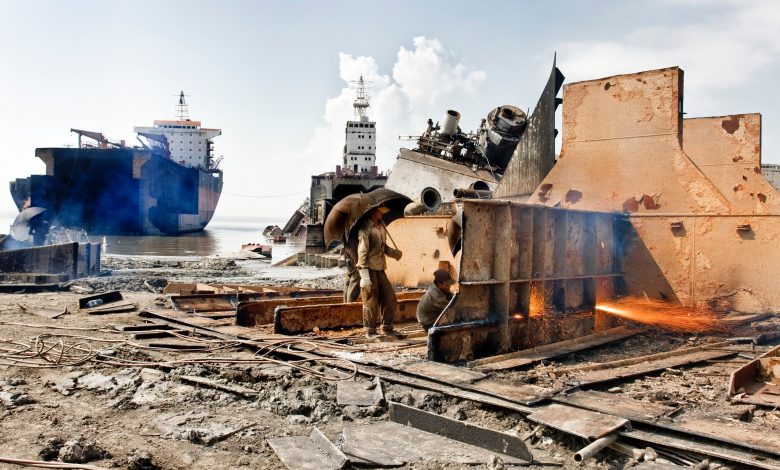Can scrap rates hold firm?

With demo rates smashing through the $400 per ldt mark, chief correspondent Jason Jiang investigates how long this recycling run can last.
The year has got off to a very firm start when it comes to demo rates, with South Asian buyers paying in excess of $400 per ldt for ships recently. The key $400 threshold has been hit largely on the back of the very limited number of ships being sent for scrap, forcing a bidding war led by the Bangladeshis for available tonnage. How long this state of affairs can continue is debatable.
“Continued positivity in prices reflected an increasingly bullish international ship recycling market for yet another week,” GMS, the world’s largest cash buyer of ships and offshore assets, says in its latest report. “During the corresponding period last year, there was talk of a potential ship recycling recession as several yards went bankrupt and prices teetered on the precipice in the low $200sper ldt. There was also talk of levels possibly declining into the $100sper ldt. However, what a turnaround we have witnessed in a matter of 12 months as prices now escalate beyond the mid-$300s per ldt, with anticipation running high that even $400sper ldt might appear on the horizon, should the current trend persist.”
Christine Mavromichalis, an executive director at GMS, reckons that the rise in local steel prices is the main reason for the firm ship recycling values.
According to Mavromichalis, 12 mm plate prices in India have now increased to around $362 per ton from $331.5 per ton in February, while scrap steel prices are currently at about $319per metric ton, up from $281 per ton in February, which translates in an overall increase of around 9% and 13.5% respectively.
Mavromichalis believes steel prices may rise even higher, affected by the steel production capacity cut plans in China and the US administration’s latest plans for investments in infrastructure and construction sectors, and most likely ship recycling rates will remain firm in the year ahead and certainly, at better levels than in 2016.
Rakesh Khetan, CEO of Wirana Shipping, is cautiously optimistic about the outlook of the shipbreaking market.
“We believe that the prices will remain strong through the second quarter after which we will need to revisit the situation then. Prices for the year ahead will probably be volatile as there are a lot of global factors that keep on affecting the market which make it difficult, especially in the ship recycling market when combined with local factors, to predict in the long term,” Khetan says.
Mavromichalis says another reason to consider would be the increased demand in vessels for further trading, due to an increase in charter rates, which further assists in recycling values being firm.
Bulkers and containers have seen an increase in charter rates recently. In the last couple of weeks charter rates for a panamax container have crossed the $10,000 per day mark, up by around $5,000 per day. When looking at the capesize market, earnings are about $20,000 per day, which is significantly higher comparing to the rates in the previous years.
“This situation has led and will continue to lead to a lower supply of vessels sent for recycling, which will obviously come in support of the recycling values,” Mavromichalis says.
Jonathan Roach, S&P market analyst at Braemar ACM Shipbroking, reckons stronger vessel demolition pricing has also been supported by significantly less tonnage in the bulker and tanker segments heading for demolition, which has reduced the number of ships being sold to breakers in the Indian subcontinent.
Mavromichalis shares a similar view with Roach. “Fewer bulkers and containerships can help maintain these firm prices, but it remains to be seen how many tankers will enter the recycling market due to the weaker rates being experienced. Prices may become more stabilised, however, this firmness may start to weaken with the upcoming monsoon season, which traditionally puts some negative pressure on prices,” she says.
Mark Williams, managing partner of Affinity Research, reckons the current improvements in dry bulk freight rates may slow bulker scrapping for a couple of months but he expects the Ballast Water Convention will claim some victims.
“Any weakness in the middle-aged tanker asset values might encourage some more tanker demolition,” Williams says.
According to data from GMS, capesizes offered for scrap have diminished to just 13 so far in the year, comparing with 40 in the same period of last year.
Roach reckons for shipowners, the overriding factor which decides whether to scrap or not is vessel earnings not the scrap price and the demolition market is strikingly reactionary to vessel earnings.
“Bullish demolition prices will not necessarily increase the number of ships sent for demolition. Even with lower demolition prices, a bearish freight market significantly increased demolition, especially for bulk carriers and container ships,” Roach maintains.
In Roach’s opinion, for now demolition prices will continue to increase as demand outweighs supply and positive market fundamentals will increase the competition between shipbreakers for available demolition tonnage brought to market.
Mavromichalis adds that one more factor to watch for is the current situation in the ship recycling sector of Pakistan and whether or not they will begin accepting tankers, LPGs and LNG vessels for recycling again.
“In the case that they do, most likely competition will spark up, leading to recycling rates continuing on the firm side, until the end of the year,” Mavromichalis says.

The extreme high scrap rate refers to the high percentage of ‘expensive’ stainless steel used in gas carriers and which can be very well recycled to be used in the stainless steel producing process again. Scrap prices should consider this. Hence there should be two scrap prices: For ships made of mild steel and for ships with high stainless steel percentage.